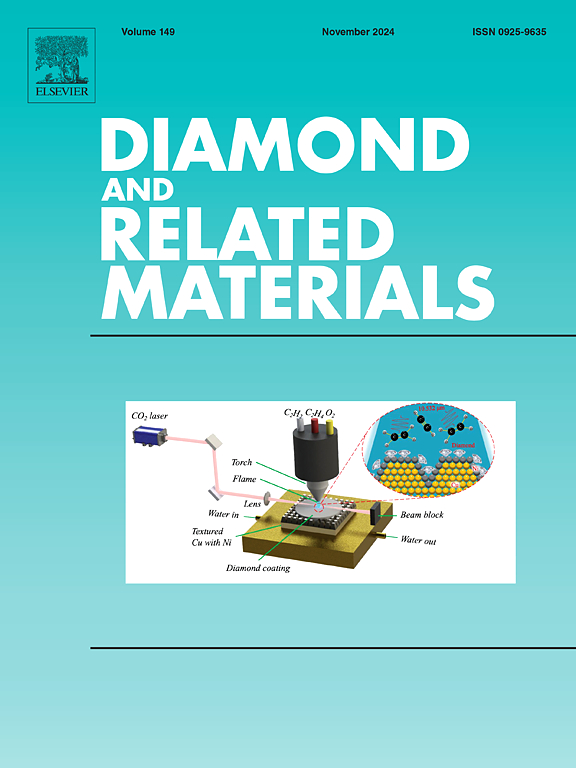新型高性能超级电容器双功能电极Pd-WO3-PPD/GO/ACGS的制备及高效水分解
IF 4.3
3区 材料科学
Q2 MATERIALS SCIENCE, COATINGS & FILMS
引用次数: 0
摘要
开发清洁和可再生能源以及超级电容器来替代化石燃料是解决环境问题的重要挑战。本研究首次将聚对苯二胺(PPD)聚合物与氧化钨(WO3)同时电化学沉积,并在氧化石墨烯(GO/ACGS)上电掺杂钯(Pd)纳米粒子。研究了Pd-WO3-PPD/GO/ACGS光电极的产氢和储能性能。采用FE-SEM、EDX-EDX作图、ATR-IR、Raman和XRD等测试手段研究了Pd-WO3-PPD/GO/ACGS光电极的表面形貌和化学结构。对Pd-WO3-PPD/GO/ACGS电极的电化学行为研究表明,在1 mA cm−2条件下,该电极的电容量为635.16 mF cm−2,在1 M H2SO4电解质溶液中,2 h后的产氢能力为31 mmol cm−2。结果表明,所制备的固态超级电容器具有177 mF cm−2的良好电容性能,最大功率密度为3500 mW cm−2,0.5 mA cm−2时的能量密度为25.02 mWh cm−2,经过7000 GCD循环后的循环稳定性和库仑效率分别为91%和99.4%。制备的电极在能源生产和存储两方面的双重应用结果表明,该电极在这两个领域都具有良好的应用潜力。本文章由计算机程序翻译,如有差异,请以英文原文为准。

Fabrication of novel Pd-WO3-PPD/GO/ACGS electrode for dual-function in high-performance supercapacitors and efficient water splitting
The development of clean and renewable energy sources as well as supercapacitors to replace fossil fuels is an important challenge to deal with environmental problems. In this study, for the first time, simultaneous electrochemical deposition of poly p-Phenylene diamine (PPD) polymer and tungsten metal oxide (WO3) followed by electrodoping of palladium (Pd) nanoparticles was carried out on graphene oxide sheets formed on anodized commercial graphite sheet (GO/ACGS). The performance of Pd-WO3-PPD/GO/ACGS photoelectrode for both hydrogen production and energy storage is investigated. Also, the surface morphology and chemical structure of Pd-WO3-PPD/GO/ACGS photoelectrode are investigated by FE-SEM, EDX-EDX mapping, ATR-IR, Raman, and XRD tests. Electrochemical behavior investigation of the Pd-WO3-PPD/GO/ACGS electrode showed excellent capacitance of 635.16 mF cm−2 at 1 mA cm−2 and a good hydrogen production ability of 31 mmol cm−2 after 2 h in 1 M H2SO4 electrolyte solution. The results of the fabricated solid-state supercapacitor device show that the fabricated device had a good capacitance of 177 mF cm−2), maximum power density of 3500 mW cm−2, an energy density of 25.02 mWh cm−2 at 0.5 mA cm−2 and excellent cyclic stability and coulombic efficiency of 91 % and 99.4 % after 7000 GCD cycles, respectively. The results of the dual application of the fabricated electrode for energy production and storage showed that this electrode has good potential for use in both fields.
求助全文
通过发布文献求助,成功后即可免费获取论文全文。
去求助
来源期刊

Diamond and Related Materials
工程技术-材料科学:综合
CiteScore
6.00
自引率
14.60%
发文量
702
审稿时长
2.1 months
期刊介绍:
DRM is a leading international journal that publishes new fundamental and applied research on all forms of diamond, the integration of diamond with other advanced materials and development of technologies exploiting diamond. The synthesis, characterization and processing of single crystal diamond, polycrystalline films, nanodiamond powders and heterostructures with other advanced materials are encouraged topics for technical and review articles. In addition to diamond, the journal publishes manuscripts on the synthesis, characterization and application of other related materials including diamond-like carbons, carbon nanotubes, graphene, and boron and carbon nitrides. Articles are sought on the chemical functionalization of diamond and related materials as well as their use in electrochemistry, energy storage and conversion, chemical and biological sensing, imaging, thermal management, photonic and quantum applications, electron emission and electronic devices.
The International Conference on Diamond and Carbon Materials has evolved into the largest and most well attended forum in the field of diamond, providing a forum to showcase the latest results in the science and technology of diamond and other carbon materials such as carbon nanotubes, graphene, and diamond-like carbon. Run annually in association with Diamond and Related Materials the conference provides junior and established researchers the opportunity to exchange the latest results ranging from fundamental physical and chemical concepts to applied research focusing on the next generation carbon-based devices.
 求助内容:
求助内容: 应助结果提醒方式:
应助结果提醒方式:


